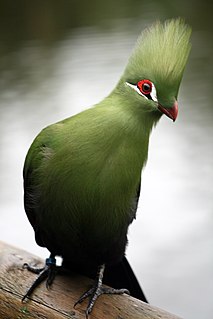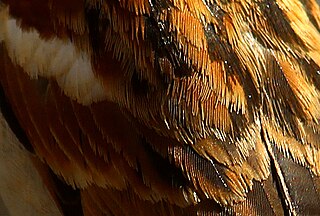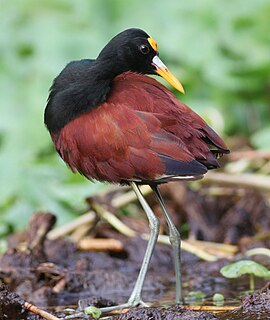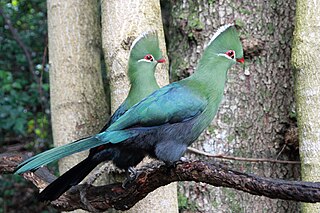
Melanin is a broad term for a group of natural pigments found in most organisms. Melanin is produced through a multistage chemical process known as melanogenesis, where the oxidation of the amino acid tyrosine is followed by polymerization. The melanin pigments are produced in a specialized group of cells known as melanocytes. Functionally, melanin serves as protection against UV radiation. Melanin (neuromelanin) functions as the catalyst of all cellular functions within an organism.

Feathers are epidermal growths that form a distinctive outer covering, or plumage, on both avian (bird) and some non-avian dinosaurs and other archosaurs. They are the most complex integumentary structures found in vertebrates and a premier example of a complex evolutionary novelty. They are among the characteristics that distinguish the extant birds from other living groups.

Galliformes is an order of heavy-bodied ground-feeding birds that includes turkeys, chickens, quail, and other landfowl. Gallinaceous birds, as they are called, are important in their ecosystems as seed dispersers and predators, and are often reared by humans for their meat and eggs, or hunted as game birds.

The Phasianidae are a family of heavy, ground-living birds, which includes pheasants, partridges, junglefowl, chickens, turkeys, Old World quail, and peafowl. The family includes many of the most popular gamebirds. The family is a large one and includes 184 species divided into 54 genera. It was formerly broken up into two subfamilies, the Phasianinae and the Perdicinae. However, this treatment is now known to be paraphyletic and polyphyletic, respectively, and more recent evidence supports breaking it up into three subfamilies: Rollulinae, Phasianinae, and Pavoninae. The New World quail (Odontophoridae) and guineafowl (Numididae) were formerly sometimes included in this family, but are now typically placed in families of their own; conversely, grouse and turkeys, formerly often treated as distinct families, are now known to be deeply nested within Phasianidae, so they are now included in the present family.

The turacos make up the bird family Musophagidae ( "banana-eaters"), which includes plantain-eaters and go-away-birds. In southern Africa both turacos and go-away-birds are commonly known as loeries. They are semi-zygodactylous: the fourth (outer) toe can be switched back and forth. The second and third toes, which always point forward, are conjoined in some species. Musophagids often have prominent crests and long tails; the turacos are noted for peculiar and unique pigments giving them their bright green and red feathers.

Turacin is a naturally occurring red pigment that is 6% copper complexed to uroporphyrin III. Arthur Herbert Church discovered turacin in 1869.

Carotenoids, also called tetraterpenoids, are yellow, orange, and red organic pigments that are produced by plants and algae, as well as several bacteria, and fungi. Carotenoids give the characteristic color to pumpkins, carrots, parsnips, corn, tomatoes, canaries, flamingos, salmon, lobster, shrimp, and daffodils. Carotenoids can be produced from fats and other basic organic metabolic building blocks by all these organisms. The only land dwelling arthropods known to produce carotenoids are aphids, and spider mites, which acquired the ability and genes from fungi. It is also produced by endosymbiotic bacteria in whiteflies. Carotenoids from the diet are stored in the fatty tissues of animals, and exclusively carnivorous animals obtain the compounds from animal fat. In the human diet, absorption of carotenoids is improved when consumed with fat in a meal. Cooking carotenoid-containing vegetables in oil and shredding the vegetable both increase carotenoid bioavailability.

Plumage is a layer of feathers that cover a bird and the pattern, colour, and arrangement of those feathers. The pattern and colours of plumage differ between species and subspecies and may vary with age classes. Within species, there can be different colour morphs. The placement of feathers on a bird is not haphazard, but rather emerge in organized, overlapping rows and groups, and these feather tracts are known by standardized names.

The northern jacana or northern jaçana is a wader which is known as a resident breeder from coastal Mexico to western Panama, and on Cuba, Jamaica and Hispaniola in the Caribbean. It sometimes known to breed in Texas, United States, and has also been recorded on several occasions as a vagrant in Arizona. The jacanas are a group of wetland birds, which are identifiable by their huge feet and claws, which enable them to walk on floating vegetation in the shallow lakes that are their preferred habitat. In Jamaica, this bird is also known as the 'Jesus bird', as it appears to walk on water. Jacana is Linnæus' scientific Latin spelling of the Brazilian Portuguese jaçanã, pronounced [ʒasaˈnɐ̃], from the Tupi name of the bird. See jacana for pronunciations.

Biological pigments, also known simply as pigments or biochromes, are substances produced by living organisms that have a color resulting from selective color absorption. Biological pigments include plant pigments and flower pigments. Many biological structures, such as skin, eyes, feathers, fur and hair contain pigments such as melanin in specialized cells called chromatophores. In some species, pigments accrue over very long periods during an individual's lifespan.

Tauraco is a genus of turacos. It contains the "typical" or green turacos; though their plumage is not always green all over, the presence of significant amounts of turacoverdin-colored plumage generally sets Tauraco species apart from other Musophagidae. Indeed, as opposed to any other known birds, Tauraco turacos are the only living bird taxa that have any significant green pigment whatsoever, as the greens of many parrots etc. are due to structural color, not pigment. Their genus name was derived from a native West African name.

The Knysna turaco, or, in South Africa, Knysna loerie, is a large turaco, one of a group of African musophagidae birds. It is a resident breeder in the mature evergreen forests of southern and eastern South Africa, and Swaziland. It was formerly sometimes considered to be a subspecies of the green turaco of West Africa. The Livingstone's and Schalow's turacos were once considered subspecies.

The purple-crested turaco or, in South Africa, the purple-crested loerie, is a species of bird in the clade Turaco with an unresolved phylogenetic placement. Initial analyses placed the purple-crested turaco in the family Musophagidae, but studies have indicated that these birds do not belong to this family and have been placed in the clade of Turacos with an unresolved phylogeny. It is the National Bird of the Kingdom of Eswatini, and the crimson flight feathers of this and related turaco species are important in the ceremonial regalia of the Swazi royal family.

The pin-tailed manakin is a suboscine species of bird within the manakin family, Pipridae. This species is endemic to the Eastern coast of Brazil within the humid Atlantic Forest, and its range extends from the State of Bahia to the State of Rio Grande Do Sul. The pin-tailed manakin is monotypic within the genus Ilicura, and has no known subspecies. It is a relatively small species that has pronounced sexual dimorphism. Male birds of this species have a bright white neck, chest, auriculars, and flanks. They have black and dark-green wings, with a signature pin shape tail that has a small fork near the tip, helping to give it its common name in English. The males are most easily identified by their characteristically vibrant red fore-crown and rump. The females of this species are a muted green, except for their neck and auriculars—which are light grey, and their crème colored chest. Both male and female birds of this species share a slightly elongated head shape that gives them a distinguished raised forehead. The pin-tailed manakin's vocalizations are quiet, but resemble a high-pitched “see-see-see” in descending tones.

Animal coloration is the general appearance of an animal resulting from the reflection or emission of light from its surfaces. Some animals are brightly coloured, while others are hard to see. In some species, such as the peafowl, the male has strong patterns, conspicuous colours and is iridescent, while the female is far less visible.

Psittacofulvin pigments, sometimes called psittacins are responsible for the bright-red, orange, and yellow colours specific to parrots. In parrots, psittacofulvins are synthesized by a polyketide synthase enzyme that is expressed in growing feathers. They consist of linear polyenes terminated by an aldehyde group. Colourful feathers with high levels of psittacofulvin resist feather-degrading Bacillus licheniformis better than white ones.

Solid black plumage color refers to a plumage pattern in chickens characterized by a uniform, black color across all feathers. There are chicken breeds where the typical plumage color is black, such as Australorp, Sumatra, White-Faced Black Spanish, Jersey Giant and others. And there are many other breeds having different color varieties, which also have an extended black variety, such as Leghorn, Minorca, Wyandotte, Orpington, Langshan and others.

Sexual selection in birds concerns how birds have evolved a variety of mating behaviors, with the peacock tail being perhaps the most famous example of sexual selection and the Fisherian runaway. Commonly occurring sexual dimorphisms such as size and color differences are energetically costly attributes that signal competitive breeding situations. Many types of avian sexual selection have been identified; intersexual selection, also known as female choice; and intrasexual competition, where individuals of the more abundant sex compete with each other for the privilege to mate. Sexually selected traits often evolve to become more pronounced in competitive breeding situations until the trait begins to limit the individual's fitness. Conflicts between an individual fitness and signaling adaptations ensure that sexually selected ornaments such as plumage coloration and courtship behavior are “honest” traits. Signals must be costly to ensure that only good-quality individuals can present these exaggerated sexual ornaments and behaviors.

Albinism is the congenital absence of melanin in an animal, plant, or person, resulting in white hair, feathers, scales and skin and pink eyes. Individuals with the condition are referred to as albino.

The Catalina macaw, sometimes known as the rainbow macaw is a first generation hybrid between the blue-and-gold macaw and scarlet macaw. As catalina macaws are hybrids, they do not have a true scientific name. The best way to represent these birds in taxonomy is by the expression Ara ararauna × Ara macao.






















